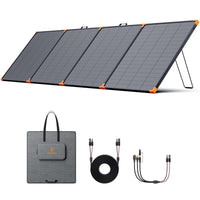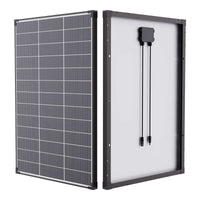How Much Do Solar Panels Cost in 2025? for Homeowners & RV Owners
As solar energy becomes more popular, many homeowners, RV enthusiasts, and business owners are considering installing solar panels to reduce electricity bills and gain energy independence. But one of the biggest questions is:
💰 How much do solar panels cost?
The answer depends on several factors, including system size, location, installation type, and available incentives. In this guide, we’ll break down:
✅ The average cost of solar panels in 2025
✅ Factors that affect solar pricing
✅ Hidden costs & additional expenses
✅ Solar incentives & financing options
✅ Buying vs. leasing: which is better?

how much are solar panels? (Home & RV Systems)
The cost of solar panels is typically measured in dollars per watt ($/W). The average price in 2025 for home solar systems in the U.S. is:
|
System Size |
Average Total Cost (Before Incentives) |
Cost per Watt |
|
5 kW (small home) |
$12,500 – $17,500 |
$2.50 – $3.50/W |
|
8 kW (medium home) |
$20,000 – $28,000 |
$2.50 – $3.50/W |
|
10 kW (large home or business) |
$25,000 – $35,000 |
$2.50 – $3.50/W |
For RV and off-grid solar systems, the cost varies based on power needs:
|
System Type |
Average Cost |
Best For |
|
100W Portable Panel |
$100 – $250 |
Small devices, camping |
|
200W Portable Panel |
$200 – $450 |
RVs, backup power |
|
400W-600W RV System |
$500 – $1,500 |
Full RV solar setup |
|
1000W+ RV System |
$2,000 – $4,000 |
Full-time RV living |
🔹 Pro Tip: Higher-efficiency panels (like ZOUPW’s N-Type panels) cost more upfront but produce more energy in less space, saving money in the long run.
what is the average cost of solar panels (2025 Update)
Solar panel costs vary by state due to installation labor rates, incentives, and electricity costs. Here are the average solar costs in different U.S. states:
|
State |
Avg. Cost per Watt |
10 kW System Cost (Before Incentives) |
|
California |
$2.75 |
$27,500 |
|
Texas |
$2.50 |
$25,000 |
|
Florida |
$2.45 |
$24,500 |
|
New York |
$3.20 |
$32,000 |
|
Arizona |
$2.60 |
$26,000 |
|
Colorado |
$2.90 |
$29,000 |
|
Washington |
$3.10 |
$31,000 |
📌 Key Takeaway: States with strong solar incentives (like California & New York) may have higher upfront costs but better savings through tax credits and rebates.
What Affects the Cost of Solar Panels?
Several factors impact the final price of a solar system:
1️、System Size & Power Output
- Larger systems cost more upfront but generate more long-term savings.
- Higher-efficiency panels require fewer panels to meet your energy needs.
2️、Panel Type & Efficiency
- Monocrystalline panels (like ZOUPW’s N-Type) cost more but have higher efficiency (25%).
- Polycrystalline panels are cheaper but less efficient (15-20%).
3️、Installation Costs & Labor
- Professional installation costs vary by state.
- DIY installation (for RVs or small systems) saves money but requires electrical knowledge.
- Foldable solar panels require no installation, just unfold them, adjust the angle, and connect to the power storage system
4️、Energy Storage (Battery Costs)
- A solar battery (like Tesla Powerwall or LiFePO4 batteries) adds $5,000 – $15,000 to the total cost.
- For RVs, a portable solar battery costs $500 – $2,000, depending on capacity.
Hidden Costs & Additional Expenses
Beyond the panels, you may need:
✅ Inverters – Convert DC to AC power ($1,000 – $3,000).
✅ Wiring & Connectors – Includes solar panel extension cables ($50 – $200),Of course, zoupw's portable solar panels are equipped with universal solar cables and other connecting cables, which are compatible with most energy storage systems on the market.
✅ Permits & Inspections – Required for home installations ($500 – $2,000).
✅ Mounting Equipment – Roof or ground-mount brackets ($500 – $2,500).
👉 For RV users, portable systems skip most of these costs, making them a cheaper solar solution.
Solar Incentives & Financing Options
1️、Federal Solar Tax Credit (ITC)
- The U.S. government offers a 30% federal tax credit for solar installations.
- If your system costs $20,000, you get $6,000 back in tax credits.
-
You can find detailed information about the Federal Solar Tax Credit (ITC) on the following official websites:
-
Internal Revenue Service (IRS) Official Website – Provides official guidance on the Residential Clean Energy Credit, including eligibility requirements and how to claim it.
-
U.S. Department of Energy (DOE) – Solar Energy Technologies Office – Offers resources explaining the Federal Solar Tax Credit, its coverage, and application process for homeowners and businesses.
-
ENERGY STAR Program – Provides information on solar energy system tax credits and how homeowners can benefit from ITC incentives.
-
2️、State & Local Rebates
- Many states offer additional solar rebates, reducing upfront costs.
- Some utilities offer net metering, meaning you sell excess power back to the grid.
3️、Solar Loans & Leasing
- Solar loans allow you to finance a system with $0 upfront cost.
- Leasing & power purchase agreements (PPAs) let you use solar power without buying panels, but savings are lower.
📌 Best Choice: Buying panels leads to bigger savings, while leasing is better for those who want solar with no upfront cost.
Buying vs. Leasing: Which is Better?
|
Factor |
Buying Solar Panels |
Leasing Solar Panels |
|
Upfront Cost |
High ($10K–$30K) |
Low ($0–$2K) |
|
Ownership |
✅ Yes |
❌ No |
|
Tax Incentives |
✅ Yes |
❌ No |
|
Energy Savings |
✅ High |
❌ Lower savings |
|
Best For |
Long-term savings |
No upfront cost option |
👉 Recommendation: If you can afford it, buying panels provides greater long-term benefits.
How Much Money Would I Save With Solar Panels?
Solar panels don’t just cost money—they save it. Over time, most homeowners save $20,000–$40,000 on electricity bills over 20–25 years.
Your savings depend on:
-
Your local electricity rates
-
Sunlight exposure
-
Incentives and financing options
-
Whether you own or lease your system
Here’s a simple example:
If your monthly bill is $150 and solar reduces it by 90%, you’ll save $1,620 per year. In 20 years, that’s $32,400 in savings.The higher your electric bill, the more you stand to gain from switching to solar.
Is Solar Worth the Cost?
✅ Home Solar: Pays for itself in 5-10 years with savings of $20,000+ over its lifetime.
✅ RV Solar: Provides off-grid power with a one-time cost of $500 – $3,000, saving on generator fuel.
✅ Portable Solar Panels: (Like ZOUPW’s PowerFold Series) offer an affordable and flexible solution for RVs and emergency power.
FAQ
How Much Do Solar Panels Cost in Texas?
Texas is one of the best states for solar due to its abundant sunshine and low installation costs.
Here’s a Texas-specific estimate:
-
Cost per watt: ~$2.40–$2.70
-
Typical 6 kW system cost: $14,000–$16,000
-
After 30% tax credit: ~$10,000–$11,000
Several local utilities (e.g., Oncor, CPS Energy) also offer additional rebates—up to $2,500 or more in savings.
How Much Are Solar Panels for a Roof?
The cost of roof-mounted solar panels typically ranges between $15,000 and $25,000 for a standard U.S. home, before tax credits or incentives. The price includes:
Solar panels (monocrystalline or polycrystalline),Inverters,Mounting hardware,Wiring,Installation labor
How Much Does It Cost to Install Solar Panels?
Installation costs can vary depending on your location, roof type (flat or sloped), and labor rates.
On average, installation accounts for 10–20% of the total solar system cost
For example:
-
Standard roof installation: ~$2,000–$5,000
-
Ground-mounted or complex roof: $5,000–$10,000+
-
Some states offer local rebates or incentives to reduce installation costs even further.
The labor cost of installing solar panels is high, and foldable solar panels are also a good backup power supply choice. ZOUPW foldable solar panels can be set up in one minute.
Final Thoughts: How Much Should You Spend on Solar?
The cost of solar panels depends on your energy needs, location, and budget. While home solar systems require higher upfront costs, they offer long-term savings and energy independence. For RV users and off-grid travelers, portable solar panels are an affordable way to harness solar energy without a major investment.
💡 Want to explore high-efficiency solar panels? Check out ZOUPW’s latest N-Type solar technology today! ☀️🔋
Share



